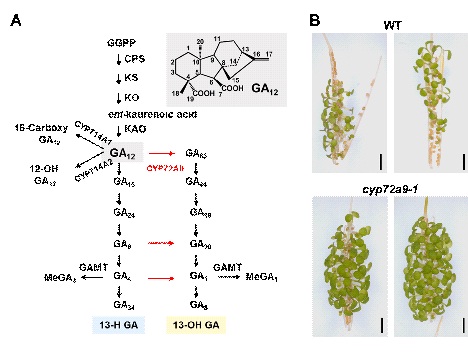Bioactive gibberellins (GAs, diterpenes) are essential hormones in land plants, controlling many aspects of plant growth and developments. In flowering plants, 13-OH (low bioactivity; such as GA1) and 13-H GAs (high bioactivity; such as GA4) frequently coexist. Thus far, only two cytochrome P450 enzymes, namely CYP714B1 and CYP714B2, were functionally identified in rice. Both CYP714B1 and CYP714B2 catalyzed the 13-hydroxylation of GA12 to form GA53 (13-OH GA12) in vitro. However, the bona fide GA 13-hydroxylase and its physiological functions in other plants including Arabidopsis thaliana remain unknown.
Recently, researchers from Dr. WANG Guodong’s group at the Institute of Genetics and Developmental Biology, Chinese Academy of Sciences, identified a new player controlling plant GAs metabolism.
They discovered that members of the CYP72A subfamily, rather than above-mentioned CYP714 subfamily, encode bona fide gibberellin 13-oxidase, which catalyzes the conversion of 13-H GAs (GA12, GA9 and GA4) to the corresponding13-OH GAs (GA53, GA20 and GA1). CYP72A9 in Arabidopsis is predominantly expressed in developing seeds. cyp72a9 mutants show a deficiency in GA1 and an increase in the concentration of GA4, suggesting that CYP72A9 plays a key role in controlling GA metabolism in Arabidopsis.
Comprehensive gibberellin profiling revealed the difference of GA metabolism between rice and Arabidopsis: GA1 was biosynthesized from far upstream precursor GA53 in rice, which GA1 was directly biosynthesized from GA4 in Arabidopsis. They further demonstrated that the conversion of GA4 to GA1 is an indispensable and conserved factor for primary seed dormancy in Brassicaceae plants.
Together, their work represents a major discovery in the fields of plant gibberellin metabolism. Additionally, primary seed dormancy is an important trait for many crops, including rapeseed, soybean, and rice etc.
The knowledge generated from this study, together with the fast developing CRISPR-Cas9 techniques, could be applied to gibberellin engineering to control seed dormancy and germination.
The research results were published online in Nature Plants entitled "CYP72A enzymes catalyse 13-hydrolyzation of gibberellins".
This work is supported by grants from the National Natural Science Foundation of China, National Key R&D Program of China and “Priority Research Program” of the Chinese Academy of Sciences.
Figure: CYP72A enzymes catalyze 13-hydrolyzation of gibberellins, indicated with red arrows (A), and controlling seeds primary dormancy in plants (B). (Image by IGDB)
Contact:
QI Lei
Institute of Genetics and Developmental Biology, Chinese Academy of Sciences
 Figure: CYP72A enzymes catalyze 13-hydrolyzation of gibberellins, indicated with red arrows (A), and controlling seeds primary dormancy in plants (B). (Image by IGDB)Contact:QI LeiInstitute of Genetics and Developmental Biology, Chinese Academy of SciencesEmail: lqi@genetics.ac.cn
Figure: CYP72A enzymes catalyze 13-hydrolyzation of gibberellins, indicated with red arrows (A), and controlling seeds primary dormancy in plants (B). (Image by IGDB)Contact:QI LeiInstitute of Genetics and Developmental Biology, Chinese Academy of SciencesEmail: lqi@genetics.ac.cn CAS
CAS
 中文
中文




.png)
